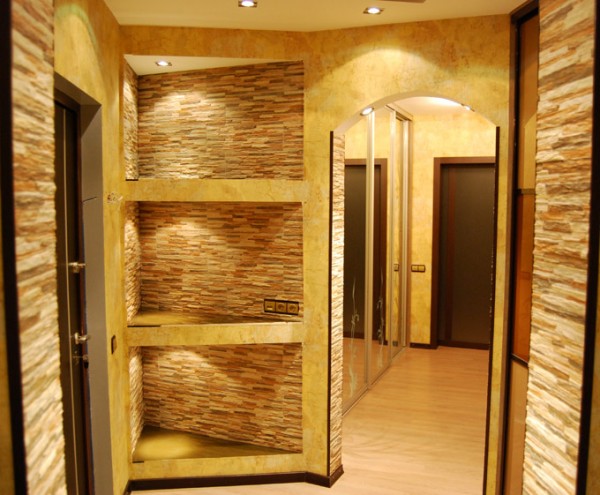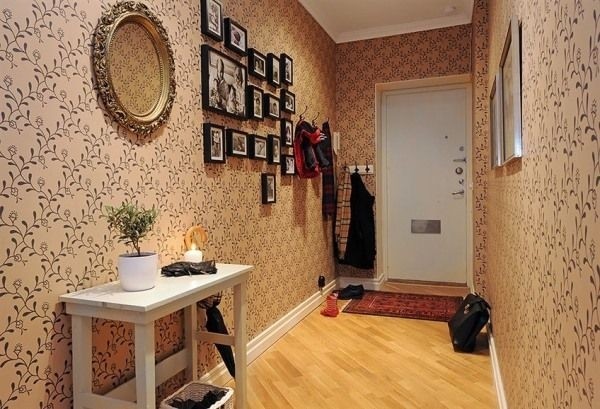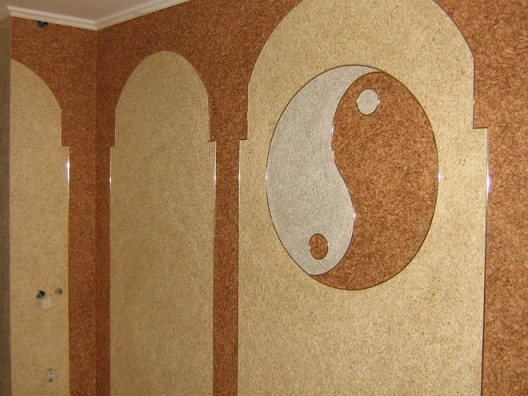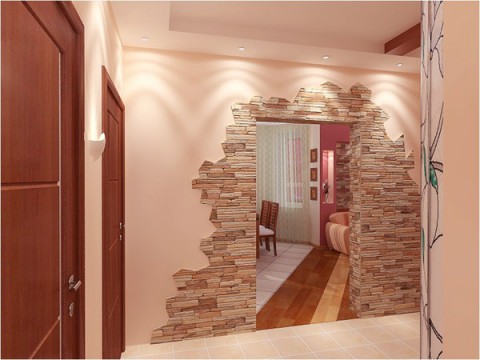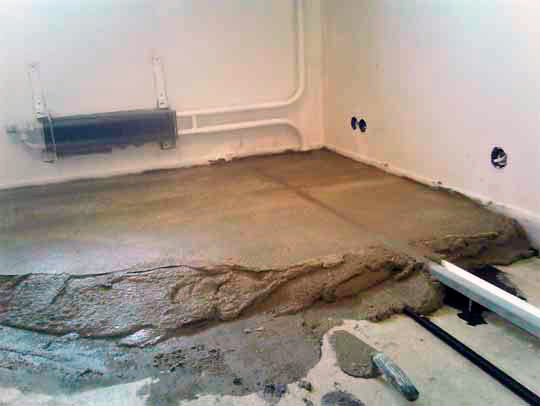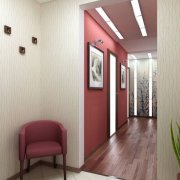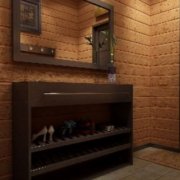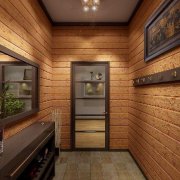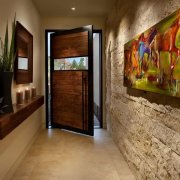Hallway decoration and choice of finishing material
If we are talking about a large house or apartment, then there are practically no restrictions on the choice of finishing material, finishing the hallways and corridors is not difficult. But what if the inheritance went to a small apartment, and the hallway is a small narrow corner near the front door.
Therefore, before you finish the hallway in the apartment, you need to decide on inexpensive finishing material in order to carry out repair work without any difficulties on your own.
The content of the article
The choice of finishing material for corridors and hallways
Today, a lot of new finishing materials have appeared, and the requirements for them have been significantly unified. Any repair, including the entrance hall, determines how the room will look after all the finishing work.
Given that the entrance hall is a small room, many ignore the design project.
Tip. Even if a simple repair is planned from inexpensive material with your own hands, it is still desirable to make a basic sketch.
Next, it is determined how to beautifully decorate the hallway, which material to choose. At the same time, do not forget that this room meets guests and hosts directly from the street.
Everything negative that is outside the apartment (dust, snow, rain, dirt) gets inside. An enormous load falls on the hallway.
Therefore, the material should possess not only external aesthetics, but also practicality, durability, wear resistance.
Tip. In addition, the small size of the room requires you to choose a material that does not provide for the installation of a frame. Frame methods include fastening decorative and plastic panels.
To summarize, the decoration materials for the hallway should be:
- Strong and durable.
- Easy to clean.
- To create a feeling of a positive mood, this is exactly how this room speaks of the residents of the house.
Hallway Wall Decoration
If we talk about inexpensive material, then we can focus on wallpaper and paint. But again, do not forget about the requirement for the material.
Raw materials should have high practicality.
So:
- Finishing material should be easily washed with detergents, therefore, if the choice fell on the wallpaper, you should choose non-woven or vinyl wallpaper. This type of material can hide only small surface defects.
- In modern repairs, washable wallpapers began to be used more and more often, they do not lose their original aesthetics after numerous treatments with detergents.
- Wallpaper for painting is also a good solution to the problem. The advantage of wallpaper for painting is to get rid of repeated repairs for a certain period, due to the possibility of a regular change of shades.
- As for the coloring matter, then everything is also simple.
More on vinyl wallpaper
This type of finishing material has two undeniable advantages. Affordable price and ease of operation.
Vinyl wallpaper for decorating the corridor is better to buy on a non-woven basis.
Tip. If the walls are with pronounced defects, it is recommended to use a thicker material with foamed vinyl.
Read more about liquid wallpaper
This type of wallpaper is considered quite expensive material. Given the widest range of cost, you can choose not very expensive material, according to your budget.
One of the advantages of liquid wallpaper is that you do not need to spend a lot of effort for the preliminary preparation of the walls. If the liquid wallpaper at the finish is varnished, this will significantly extend the service life and provide convenient care for them, see photo.
For reference. Today, liquid wallpaper manufacturers have taken care of both VIP customers and those who are counting on a modest budget. During operation, the material is rolled out and strips are carefully measured.
Read more about decorative plaster
Decorative plaster in recent years is increasingly in demand by the consumer. Many decorative plaster is confused with liquid wallpaper, but these are completely different types of finishing materials.
When applying decorative plaster is more capricious and requires careful preparatory work. But the advantage of decorative plaster is precisely in the variety of design.
Siding panels
This is a great decoration for the hallway. Installation instructions are quite simple.
Siding panels are sold in a wide range of both color solutions and external texture.
The material from which the panels are made:
- Metal.
- Plastic.
- Wood.
For reference. Preparing walls for siding panels will take some time to install the lathing and fastening the rails. At the finish, this finish will allow you to hide all the defects.
For proper installation, it is recommended to watch the video instruction.
Faux stone entrance hallway
Artificial stone trim is also often used in modern renovations. The cost of finishing will be much cheaper than natural stone, and installation is greatly simplified.
Artificial stone is a universal finish, as it can be perfectly combined with any finishing material. If the ceiling in the hallway is made with tension materials, then this will turn out to be an excellent combination.
Artificial stone combines and looks great:
- with stucco molding
- ceramic tiles
- decorative plaster
- wallpaper
- drywall.
For reference. Thanks to artificial stone, you can beautifully finish not only the walls, but different niches, shelves and just separate elements. They can finish metal, wood and brick products.
Finishing in the hallway floor and ceiling
A variety of materials can be used to finish the ceiling structure.
Here you can use the following finishing materials:
- Painting.
- Stretch ceiling.
- Drywall finish.
- Wallpapering.
- Plaster is ordinary and decorative.
- All types of suspension structures.
The choice of material directly depends on financial capabilities and design.
Hallway flooring, material selection
Considering all the difficulties of this room, a reliable durable and beautiful material should act as a material on the floor. How to trim the floor in the hallway?
The most popular materials used to decorate the floor in the corridor:
- A rock.
- Tile.
- Linoleum.
- Laminate.
All of these materials are classified as durable and affordable.
Stages of repair work
If you look at the hallway as an ordinary room, you must adhere to the plan, as in any room in the apartment. It all starts with the dismantling of the old material and preparing the room for repair.
Before painting, decorative plastering or wallpapering, the surface requires specific preparation of walls and ceilings. If we are talking about panels and materials related to the crate, then special preparation will not be needed, except for the elimination of minor defects.
Attention! If the tensioning structure is chosen as the finishing material of the ceiling, then it should be installed last, after finishing the walls.
Alignment of wall surfaces
The surface of the walls is leveled using putty in two layers. The first layer evens out the surface, drops are removed, so it is applied thick.
The second, finishing layer gives the surface a maximum smooth effect. After each layer, the wall must be primed. The very last step is sanding with sandpaper and applying a primer.
Before you finish the floor in the hallway, it must be leveled with a screed based on cement mortar. This is the most optimal and inexpensive option for leveling the floor surface.
We mount the finishing material
If any type of wallpaper is used as the finishing material for the walls, then when laying, make sure that they are glued butt. When gluing vinyl and non-woven wallpaper, glue is applied not to the material, but to the wall surface.
The technology for applying paint to the wall is different everywhere. Water-based paint is applied in several layers in different directions. For example, the first layer goes horizontally, the second vertically.
It is not necessary to wait for each layer to dry completely.
For reference. The technology for applying oil paint is slightly different. The first layer is rubbed along the wall in different directions, and the second is applied strictly vertically.
Laying laminate, tile, linoleum or stone on the floor is not a big problem. Today, thanks to new technologies and modern materials, any man can cope with styling, without special professional skills.
Lighting in the hallway is an important component of the interior of this room. The best option would be if you install one bright light in the room that covers the entire territory, rather than breaking it down into several sources.
